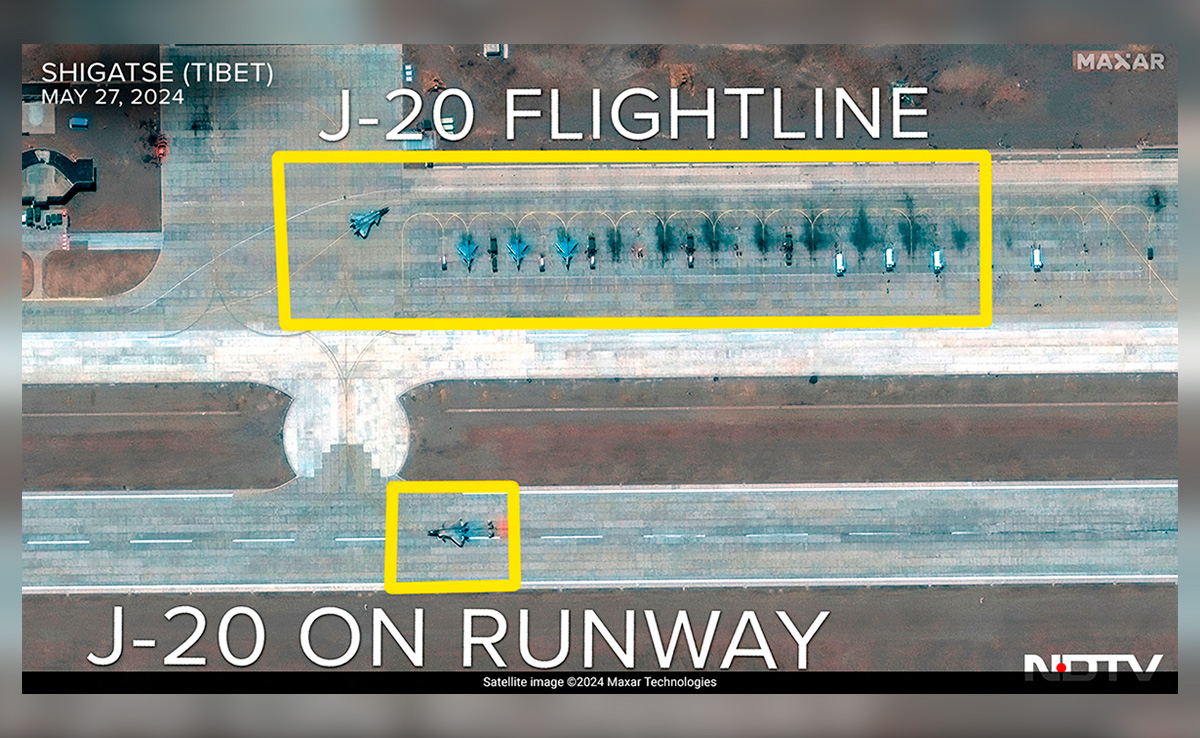China has manufactured close to 250 J-20s, its most advanced fighter jet. High-res here
New, high resolution satellite imagery available with NDTV show several J-20s, China’s most advanced stealth fighter, landing at a key high-altitude Tibetan air base located less than 150 kilometres from the Sikkim border.
Shigatse airfield also lies less than 300 kilometres from the Indian Air Force’s base in Hasimara in Bengal which hosts the IAF’s second squadron of 16 Rafale fighter aircraft. These Rafales are tasked with defending the Himalayan frontier over Eastern India.
India presently operates two Rafale squadrons with 36 jets in total. China, it is believed, has already manufactured close to 250 J-20 stealth fighters. Till recently, the J-20 was primarily deployed on its Eastern frontier, defending the Pacific seaboard.
The presence of at least seven J-20s at Shigatse has major military implications for India.

The Shigatse airbase has been significantly upgraded over the last 3 years. High-res here
Located at an altitude of 12,408 feet, Shigatse, the second largest city in Tibet, has a dual-use airport for civil and military use. The deployment of the J-20 shows its ability to operate from the harsh environment of ultra-high altitude Tibetan air bases.
The presence of the fighters also indicate that the Chinese Air Force may have deployed infrastructure to sustain operations of the fighters in the area before a possible full-fledged, permanent deployment.
The Indian Air Force has declined a request for comment on the significance of the J-20 deployment.
”The forward presence of the J-20 in Tibetan airfields is a clear and present threat to the Indian Air Force. This erodes the advantage enjoyed by IAF assets like the Rafale and imposes caution against the PLAAF [Chinese Air Force],” says Sameer Joshi, a former fighter pilot, now the CEO of NewSpace Research which is developing drones for the Indian Armed forces. ”This capability, combined with an increase in the available numbers of modern fighters in the Chinese inventory, clearly negates the numerical advantage in modern jets that the IAF has enjoyed for some time.”
The images shown in this report, captured on May 27, show a J-20 deploying its drogue parachute to slow down upon landing at Shigatse, as other J-20s taxi to the flight-line. Another image shows a J-20 moving past a couple of Chinese F-7s, a license-built variant of Russia’s venerable MiG-21. China began domestic manufacture of the J-7 in 1964. Its new J-20 stealth fighter first flew in 2011.

Satellite imagery from May 27 captured a J-20 having deployed its brake parachute upon landing in Shigatse. High-res here
“The J-20 stealth fighter is China’s most advanced operational fighter aircraft to date, and these aircraft are predominantly based in the eastern provinces of China,” according to Sim Tack, a Geospatial analyst with All Source Analysis, which first reported the deployment of the J-20s earlier in the week in Shigatse. ”Seeing these aircraft appear at Shigatse in Tibet positions them on a deployment outside of their normal areas of operations and within proximity of the Indian border.”
This isn’t the first time the J-20 has been deployed in Tibet. The jets have been observed in Xinjiang in China’s Hotan prefecture between 2020 and 2023. This, however, is believed to be the largest deployment of the J-20 which has been spotted by commercially available satellite imagery.
China’s deployment of the J-20 in Shigatse is meant to send India a message says Commodore TJ Maolankar (retired), a former Chief Test pilot on India’s Tejas fighter which he landed, for the first time, on India’s aircraft carrier, INS Vikramaditya.
”On the one hand it clearly demonstrates that the Chinese have fully incorporated significant combat aviation into their frontline capabilities over the Himalayas. On the other it underscores yet again the unavoidable vulnerability of fixed airfields. Is it that the Chinese don’t mind showing them off like this because they do not believe we have the means or the will to strike at them first?”
The Chengdu J-20, also known as the Mighty Dragon, is a twin-engine stealth fighter which was introduced into service in 2017. With the induction of the fighter, China emerged as the third country in the world to operationally field stealth fighters. The jet, which is equipped with an array of sensors, is being constantly modernised. Its primary role is as an air superiority fighter and it carries China’s most advanced air to air missiles, including the PL-15 long range air to air missile which is believed to have the ability of striking aerial targets upto 300 kilometres away.

A J-20 stealth fighter moves past an obsolete J-7 jet, a Chinese variant of the Russian MiG-21. High-res here
Operating in conjunction with drones, airborne warning aircraft and electronic warning platforms, the J-20 will be able to ”deploy quickly over large swathes of Tibet in a fused awareness spectrum, helping operationalise for the first time, an ‘intelligentised’ large area defensive doctrine for the PLAAF,” says Sameer Joshi. In simple terms, this means that the J-20 has the capability to operate as a key part of a deeply networked and electronically enabled force which uses several new aviation assets including state of the art drones, new generation fighters and older assets, connected electronically through data-links which enable the force to deploy together as a cohesive warfighting unit.
”China has steadily built up its air power capacity in Tibet and other areas near India over the past five years. This has primarily consisted of the construction of new air bases and upgrading the infrastructure at existing air bases,” says Sim Tack. China has also begun deploying aircraft such as the J-20 and its H-6 nuclear-capable bombers to these border regions, at least on a temporary basis.
India matches this Chinese airfield expansion by significantly upgrading its own airbases with hardened shelters for its aircraft in addition to expanding its tiered surface-to-air missile defences, which has included the deployment of the Russian-built S-400 long range surface to air missile system in Eastern India.

The Shigatse airbase lies less than 300 kilometres from India’s second Rafale airbase in Hasimara, Bengal
The deployment of the S-400 system, which reportedly has the ability to track stealth platforms, is designed to deter offensive Chinese fighter-sweeps along the Line of Actual Control.
While a key part of India’s defences, the S-400, acquired from Russia in a Rs 40,000 crore ($5.43 billion) deal signed in 2018 has been shown to be vulnerable while under attack in the war in Ukraine. Most recently, a video has emerged of an S-400 unit composed of radars, missile launchers and other vehicles being destroyed by Ukrainian-launched ATACMS ballistic missiles which it was, evidently, unable to intercept.
Ironically, both China and India operate the same S-400 missile system, imported from Russia.







